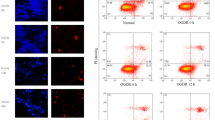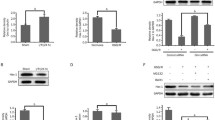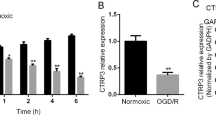Abstract
Cerebral ischemia–reperfusion injury is pivotal in the development of multiple-subcellular organelle and tissue injury after acute ischemic stroke. Recently, the Golgi apparatus (GA) has been shown to be a key subcellular organelle that plays an important role in neuroprotection against oxygen–glucose deprivation/reperfusion (OGD/R) injury. PAQR3, a scaffold protein exclusively localized in the GA, was originally discovered as a potential tumor suppressor protein. PAQR3 acts as a spatial regulator of Raf-1 that binds Raf-1 and sequesters it to the GA, where it negatively modulates the Ras/Raf/MEK/ERK signaling pathway in tumor models. Studies suggest that suppression of the ERK pathway can alleviate OGD/R-induced cell apoptosis. However, whether PAQR3 has potential effects on ischemic stroke and the underlying mechanism(s) remain unexplored. The current study is the first to show that PAQR3 was significantly downregulated in mouse neuroblastoma (N2A) cells upon OGD/R exposure, both at the mRNA and protein levels. Compared to that in controls, the mRNA level of PAQR3 began to decline at 0 h (0 h) after reperfusion, while the protein level began to decline at 4 h. Furthermore, overexpression of PAQR3 reduced OGD/R-induced apoptosis. The mRNA and protein levels of total ERK1 and ERK2 were unaltered, while activated p-ERK1 and p-ERK2 were decreased in N2A cells transfected with a PAQR3 expression vector after OGD for 4 h plus 24 h of reperfusion. Collectively, these data indicated that increased PAQR3 expression protected against OGD/R-induced apoptosis possibly by inhibiting the ERK signaling pathway. Therefore, PAQR3 might be a new attractive target in the treatment of OGD/R insult, and the underlying mechanism will pave the way for its potential experimental and clinical application.




Similar content being viewed by others
References
Avruch J (2007) MAP kinase pathways: the first twenty years. Biochim Biophys Acta 1773:1150–1160
Bai G, Chu J, Eli M, Bao Y, Wen H (2017) PAQR3 overexpression suppresses the aggressive phenotype of esophageal squamous cell carcinoma cells via inhibition of ERK signaling. Biomed Pharmacother 94:813–819. https://doi.org/10.1016/j.biopha.2017.07.154
Dal-Cim T, Poluceno GG, Lanznaster D, de Oliveira KA, Nedel CB, Tasca CI (2019) Guanosine prevents oxidative damage and glutamate uptake impairment induced by oxygen/glucose deprivation in cortical astrocyte cultures: involvement of A1 and A2A adenosine receptors and PI3K, MEK, and PKC pathways. Purinerg Signal. https://doi.org/10.1007/s11302-019-09679-w
Fan F, Feng L, He J, Wang X, Jiang X, Zhang Y, Wang Z, Chen Y (2008) RKTG sequesters B-Raf to the Golgi apparatus and inhibits the proliferation and tumorigenicity of human malignant melanoma cells. Ccarcinogenisis 29:1157–1163
Feng L, Xie X, Ding Q, Luo X, He J, Fan F, Liu W, Wang Z, Chen Y (2007) Spatial regulation of Raf kinase signaling by RKTG. Proc Natl Acad Sci USA 104:14348–14353
Hankey GJ (2017) Stroke. Lancet 389:641–654
Huang W, Guo W, You X, Pan Y, Dong Z, Jia G, Yang C, Chen Y (2017) PAQR3 suppresses the proliferation, migration and tumorigenicity of human prostate cancer cells. Oncotarget 8:53948–53958
Huang Y, Hu Z (2018) UBIAD1 protects against oxygen-glucose deprivation/reperfusion-induced multiple subcellular organelles injury through PI3K/AKT pathway in N2A cells. J Cell Physiol 233:7480–7496
Jiang Z, Hu Z, Zeng L, Lu W, Zhang H, Li T, Xiao H (2011) The role of the Golgi apparatus in oxidative stress: is this organelle less significant than mitochondria? Free Radic Bio Med 50:907–917
Kellokumpu S (2019) Golgi pH, ion and redox homeostasis: how much do they really matter? Front Cell Dev Biol 7:93. https://doi.org/10.3389/fcell.2019.00093
Kong T, Liu M, Ji B, Bai B, Cheng B, Wang C (2019) Role of the extracellular signal-regulated kinase 1/2 signaling pathway in ischemia-reperfusion injury. Front Physiol 10:1038. https://doi.org/10.3389/fphys.2019.01038
Li DJ, Li YH, Yuan HB, Qu LF, Wang P (2017) The novel exercise-induced hormone irisin protects against neuronal injury via activation of the Akt and ERK1/2 signaling pathways and contributes to the neuroprotection of physical exercise in cerebral ischemia. Metabolism 68:31–42. https://doi.org/10.1016/j.metabol.2016.12.003
Lin Y, Liu Q, Chen C, Chen W, Xiao H, Yang Q, Tian H (2017) Effect of acupuncture combined with hypothermia on MAPK/ERK pathway and apoptosis related factors in rats with cerebral ischemia reperfusion injury. Zhong Nan Da Xue Xue Bao Yi Xue Ban 42:380–388
Liu B, Luo C, Zheng Z, Xia Z, Zhang Q, Ke C, Liu R, Zhao Y (2018) Shengui Sansheng San extraction is an angiogenic switch via regulations of AKT/mTOR, ERK1/2 and Notch1 signal pathways after ischemic stroke. Phytomedicine 44:20–31. https://doi.org/10.1016/j.phymed.2018.04.025
Ma Z, Wang Y, Piao T, Li Z, Zhang H, Liu Z, Liu J (2015) The tumor suppressor role of PAQR3 in osteosarcoma. Tumour Biol 36:3319–3324
Maddahi A, Chen Q, Edvinsson L (2009) Enhanced cerebrovascular expression of matrix metalloproteinase-9 and tissue inhibitor of metalloproteinase-1 via the MEK/ERK pathway during cerebral ischemia in the rat. BMC Neurosci 10:56. https://doi.org/10.1186/1471-2202-10-56
Mohamed SK, Ahmed A, Elmorsy EM, Nofal S (2019) ERK activation by zeranol has neuroprotective effect in cerebral ischemia reperfusion. Life Sci 227:137–144. https://doi.org/10.1016/j.lfs.2019.04.035
Peng W, Lei Q, Jiang Z, Hu Z (2014) Characterization of Golgi scaffold proteins and their roles in compartmentalizing cell signaling. J Mol Histol 45:435–445
Pignataro G, Esposito E, Sirabella R, Vinciguerra A, Cuomo O, Di Renzo G, Annunziato L (2013) nNOS and p-ERK involvement in the neuroprotection exerted by remote postconditioning in rats subjected to transient middle cerebral artery occlusion. Neurobiol Dis 54:105–114. https://doi.org/10.1016/j.nbd.2013.02.008
Ramos JW (2008) The regulation of extracellular signal-regulated kinase (ERK) in mammalian cells. Int J Biochem Cell Biol 40:2707–2719
She DT, Wong LJ, Baik SH, Arumugam TV (2018) SIRT2 inhibition confers neuroprotection by downregulation of FOXO3a and MAPK signaling pathways in ischemic stroke. Mol Neurobiol 55:9188–9203
Tang YT, Hu T, Arterburn M, Boyle B, Bright JM, Emtage PC, Funk WD (2005) PAQR proteins: a novel membrane receptor family defined by an ancient 7-transmembrane pass motif. J Mol Evol 61:372–380
Wang M, Liang X, Cheng M, Yang L, Liu H, Wang X, Sai N, Zhang X (2019) Homocysteine enhances neural stem cell autophagy in in vivo and in vitro model of ischemic stroke. Cell Death Dis 10:561
Wang X, Li X, Fan F, Jiao S, Wang L, Zhu L, Pan Y, Wu G, Ling ZQ, Fang J, Chen Y (2012) PAQR3 plays a suppressive role in the tumorigenesis of colorectal cancers. Carcinogenesis 33:2228–2235
Wu Q, Zhuang K, Li H (2016) PAQR3 plays a suppressive role in laryngeal squamous cell carcinoma. Tumour Biol 37:561–565
Xie X, Zhang Y, Jiang Y, Liu W, Ma H, Wang Z, Chen Y (2008) Suppressive function of RKTG on chemical carcinogen-induced skin carcinogenesis in mouse. Carcinogenesis 29:1632–1638
Xu Y, Deng N, Wang X, Chen Y, Li G, Fan H (2017) RKTG overexpression inhibits proliferation and induces apoptosis of human leukemia cells via suppression of the ERK and PI3K/AKT signaling pathways. Oncol Lett 14:965–970
Yeo HJ, Shin MJ, Yeo EJ, Choi YJ, Kim DW, Kim DS, Eum WS, Choi SY (2019) Tat-CIAPIN1 inhibits hippocampal neuronal cell damage through the MAPK and apoptotic signaling pathways. Free Radic Biol Med 135:68–78. https://doi.org/10.1016/j.freeradbiomed.2019.02.028
Yu X, Li Z, Chan MT, Wu WK (2015) PAQR3: a novel tumor suppressor gene. Am J Cancer Res 5:2562–2568
Zhang J, Tan J, Hu Z, Chen C, Zeng L (2019) HDAC6 inhibition protects against OGDR-induced golgi fragmentation and apoptosis. Oxid Med Cell Longev 2019:6507537. https://doi.org/10.1155/2019/6507537
Zhong B, Hu Z, Tan J, Lu T, Lei Q, Chen C, Zeng L (2015) Hsp20 protects against oxygen-glucose deprivation/reperfusion-induced golgi fragmentation and apoptosis through Fas/FasL pathway. Oxid Med Cell Longev 2015:1–10. https://doi.org/10.1155/2015/606934
Zhou F, Wang S, Wang J (2017) PAQR3 inhibits the proliferation and tumorigenesis in esophageal cancer cells. Oncol Res 25:663–671
Zhu BL, Xie CL, Hu NN, Zhu XB, Liu CF (2018) Inhibiting of GRASP65 phosphorylation by DL-3-N-butylphthalide protects against cerebral ischemia-reperfusion injury via ERK signaling. Behav Neurol 2018:5701719. https://doi.org/10.1155/2018/5701719
Author information
Authors and Affiliations
Contributions
All authors contributed to the study conception and design. Material preparation, data collection and analysis were performed by WP. The first draft of the manuscript was written by WP and all authors commented on previous versions of the manuscript. All authors read and approved the final manuscript.
Corresponding author
Ethics declarations
Conflict of interest
The authors declare that they have no conflict of interest.
Additional information
Publisher's Note
Springer Nature remains neutral with regard to jurisdictional claims in published maps and institutional affiliations.
Rights and permissions
About this article
Cite this article
Peng, W., Mo, X., Li, L. et al. PAQR3 protects against oxygen–glucose deprivation/reperfusion-induced injury through the ERK signaling pathway in N2A cells. J Mol Hist 51, 307–315 (2020). https://doi.org/10.1007/s10735-020-09881-w
Received:
Accepted:
Published:
Issue Date:
DOI: https://doi.org/10.1007/s10735-020-09881-w




